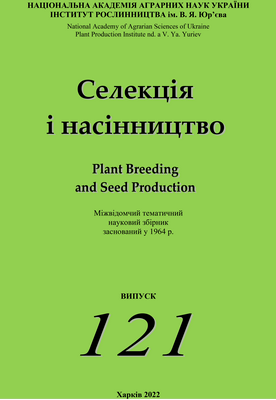Adaptability of winter bread wheat by environmental plasticity and stability
DOI:
https://doi.org/10.30835/2413-7510.2022.260998Keywords:
adaptability, winter bread wheat, genotypic effect, stability, plasticity, freeze tolerance, yield, sourceAbstract
Purpose and objectives. The work was aimed to determine the winter bread wheat adaptability by environmental plasticity and stability via assessing yields and to identify high-yielding sources adapted to the Eastern Forest-Steppe of Ukraine.
Material and methods. Twenty-nine winter bread wheat (Triticum aestivum L.) accessions from nine countries were studied: 14 mid-tall accessions and 15 short-stemmed ones. The accessions were studied and their adaptability was determined by appropriate methods using general-scientific, special and genetic-statistical approaches.
Results and discussion. It was determined that the genotypic effect (εi) for yield ranged from 0.08 to 3.88 in the mid-tall group and from 0.11 to 5.64 in the short-stemmed group. The best adaptability (sum of ranks 2) in terms of environmental plasticity and stability was recorded for two mid-tall high-yielding domestic varieties (Haiok (εi = 2.24; Ri = 0.97) and MIP Lada (εi = 0.90; Ri = 0.92) (UKR)) and for two short-stemmed ones (sum of ranks 3) (MIP Valensiia (εi = 0.11; Ri = 0.67) (UKR) and Patras (εi = 1.38; Ri = 1.18) (DEU)). Dyvo and Optima Odeska (UKR) were noticeable for high freeze tolerance (7 points).
Conclusions. The study demonstrated that the highest genetic potential of adaptability in combination with high yields was intrinsic to the mid-tall domestic genotypes, Haiok and MIP Lada (UKR), which are valuable starting material for creating highly adaptable and promising winter bread wheat varieties for the Eastern Forest-Steppe of Ukraine.
References
Morhun VV, Havryliuk MM, Oksiom VP. Introduction intro production of new, resistant to stressors, hisgh-yielding varieties of winter wheat created via chromosomal engineering and marker –assisted selection. Nauka ta Innovatsiia. 2014; 10(5): 40–48. https: doi.org//10.15407/scin10.05.040.
Siukov VV, Zakharov VG, Menibaev AI. Ecological selection of plants: types and practice. Vavilov Journal of Genetics and Breeding. 2017. 21(5): 534–536. https: doi.org//10.18699/VJ17.270.
Riabchun VK, Kuzmyshyna NV, Boguslavskyi RL and other. Introduction of plants as a priority area of scientific and practical activities of the National Center for Plant Genetic Resources of Ukraine. Genetychni Resursy Roslyn. 2019. 24: 11–25. https: doi.org//10.36814/prg.2019.24.01.
Shchipak GV, Shevchenko YuN, Matvietz VG. Improvement of adaptability as a strategic trend in wheat breeding. Visnyk Tsentru Naukovoho Zabezpechennia APV Kharkivskoi Obl. 2011; 10: 280–285.
Morgunov AI, Naumov AA. Breeding grain crops for yield stabilization: an overview information. Moskow: VNIITEI agroprom, 1987. 61 p.
Finlay KW, Wilkinson GN. The analysis of adaptation in plant breeling. Agricultur Resource. 1983; 14(6): 747–756.
Tishchenko VN, Chekalin VM. Genetic principles of the adaptive breeding of winter wheat sn the forest-steppe zonne. In: Winter wheat breeding using molecular genetic marcers: monograph. Poltava, 2005. P. 184–203.
Cherniaieva IM, Petrenkova VP, Lushna IS. Creation of starting matersal for winter bread wheat breeding for resistance to diseases. Sel. Nasinn. 2011; 100: 59–65. https: doi.org//10.30835/2413-7510.2011.66294.
Ulich OL, Tereshchenko YuF. Adaptive varieties of winter wheat for the forest-steppe – steppe transitional subzone. In: Agronomist. Kyiv: TOV “AgroMedia”, 2018. P. 96–102.
Babayants LT, Babayants OV. New introgressed genes of resistance to phitopathogenes and their use in wheat breeding for immunity. Zbirnyk Naukovykh Prats SHI-NTsNS. 2008; 11: 12–19.
Popov SI, Leonov OYu, Popova KM, Avramenko SV. Environmental plasticity of winter wheat varieties depending on root nitrogen fertilizers sn the eastern Forest-Steppe of Ukraine. Sortovyvchennia ta Okhorona Prav na Sorty Roslyn. 2019; 15(3): 296–302. https: doi.org//10.21498/2518-1017.15.3.2019.181087.
Litun PP. Genotype- environment interaction in genetic research and methods of its study. Problems of selection and evoluation of breeding material. Kyiv: Naukova dumka, 1980. P. 63–93.
Кilchevskiy AV, Khotylyova LV. Genotype and environment in plant breeding. Minsk: Nauka i Tekhnika, 1989. 191 p.
Dospekhov BA. Methods of field experimentation (with basics of statistical processing of research data). Moscow: Agropromizdat, 1985. 351 p.
Merezhko AF, Udachin RA, Zuyev VYu, et al. Enrichment preservation sn live condition and exploration of the world collection of wheat, aegilops and triticale. Methodical guidelsnes. Sankt Peterburg: VIR, 1999. 81 p.
CMEA’s extended harmonized classifier of the genus TriticumL. Leningrad, 1985. 42 p.
Guriev BP, Litun PP, Gurieva IA. Methodical recommendations on ecologicak variety testing corn. Kharkiv, 1981. 31 p.
DSTU 4749:2007 Winter wheat. Method for determinsng frost resistance of varietses. Valid from 2009-01-01. Kyiv: Derzhshozhywstandart Ukraine. 2008. 8 p.
Downloads
Published
Issue
Section
License
Copyright (c) 2022 A. V. Yarosh, V. K. Riabchun, N. I. Riabchun

This work is licensed under a Creative Commons Attribution 4.0 International License.
When placing the text in electronic resources, the copyright is reserved by the author of a publication.
Authors may not agree with referee’s(s’) comments and remarks of the Editorial Board, rationalizing their point of view.
Authors may require clarification from or the Editorial Board or changes in the event of significant errors in their article.
Authors can use materials published in the journal Selection and Seed Industry in their work, mandatorily referring to our journal.

